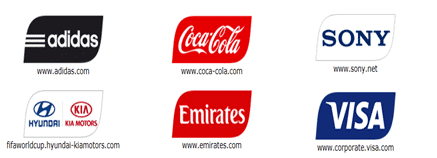Check out the post for World Cup Sponsorships 2018 here
For one month this summer, 32 footballing nations and a global audience will focus their attention on Brazil for the 20th edition of the FIFA World Cup. With so many eyes and ears concentrated on one place for an extended period of time, the desire to cash in on the event is strong – but it will come at a cost.
FIFA is expected to generate $4 billion in revenue for the upcoming tournament, with $1.4 billion coming from sponsorship revenue from 22 companies ($2.6 billion will be generated by TV rights to the matches). Since the 2006 Word Cup, sponsorship revenue increased 33% for the 2010 World Cup in South Africa, and is expected to increase another 10% for the 2014 edition.
So is sponsoring the World Cup worth it? Will the tens to hundreds of millions of dollars spent by the sponsoring organizations be returned in sales growth? The answer is a bit complicated and requires a deeper look at the marketing affiliate structure within FIFA, as well as the uniqueness of each of the industries.
The New Strategy Paying Dividends (at Least for FIFA)
Beginning in 2006 after the World Cup in Germany, FIFA created a new commercial strategy with the cornerstone consisting of three Sponsorship Tiers:
FIFA Partners
Estimated to spend $730 million combined for the rights in 2014, the six FIFA Partners have the highest level of association with FIFA. Their relationship with soccer’s governing body extends beyond the World Cup, covering all major events, and supporting football globally.

FIFA World Cup Sponsors
With an aggregate spend estimated at $500 million, the eight FIFA World Cup Sponsors have rights to the FIFA Confederations Cup and the FIFA World Cup on a global basis.

National Supporters
This level will spend about $170 million combined in 2014 with rights limited to the host country (Brazil) only.

Return on Investment Likely to Vary Significantly
While ROI can be difficult to measure for major Sports Marketing investments, some directional results can be surmised.
FIFA partners such as Coke, with immense scale and global presence, likely benefit both in the short term (through incremental sales) and long term (building equity and brand loyalty).
Budweiser (INBEV), sponsoring its eighth consecutive World Cup, has secured pouring rights for all World Cup venues, and will likely score points off the field due to their role in getting the Brazilian government to temporarily lift the ban of alcohol sales at stadiums. Driving trial at matches being attended by fans from around the world may help break down the barriers American beers have faced – often being criticized as ‘watered down’ versions of ‘real’ beer.
Even some large, global companies will struggle to generate decent returns, however. Adidas has long been a FIFA sponsor, and although Adidas will have exclusive rights to World Cup events, there is built-in competition simply from the nations competing on the pitch. The host country, Brazil – in addition to traditional powers England, France, and Portugal - is sponsored by Nike.
Nike has managed to gain significant ground on Adidas in the football gear and outfitting business and launched a major ambush campaign during the 2010 World Cup that generated a larger buzz than any of the official sponsors.
The smaller, local organizations will likely find strong returns harder to attain due to scale and competition. Some local companies do not have the scale to drive the sales necessary to recoup their investment, and far too many competitors to official sponsors are able to market themselves aggressively in the World Cup environment without breaking any rules (or at least being caught breaking the rules).
Digital Strategy: Maximize Owned and Capitalize on Earned Media
Regardless of the sponsors’ likelihood to achieve a strong ROI, a key area on which to focus is the Digital and Social space. Owned properties such as brand website and Facebook pages generate engagement and online interaction that enhance sales from paid activities.
Analytic Partners studies have shown that Owned and Earned engagement has boosted incremental sales from Paid marketing an additional 2%-6%. So for every $1 billion in revenue (assuming a 50% organic base), a strong digital and social program could generate an additional $10-$30 million in sales enhancement.
That will certainly help close that gap between an unprofitable and profitable Sports Marketing investment!
While the world’s top footballing nations battle it out on the pitch, corporate sponsors of the World Cup will be battling each other, themselves, and the high cost of World Cup sponsorship to win victories in the marketplace.
To learn more about maximizing your Digital & Social Media advertising, please visit our Digital & Social Media ROI services page.




